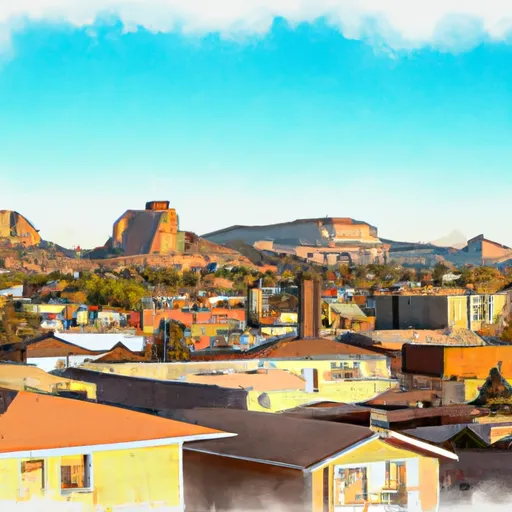-
 Snoflo Premium
Snoflo Premium
Get unlimited access to all our content
With no Ad interruptions! - Start Your Free Trial Login with existing account
Rimrock
Eden Index
Climate
9.3
•
Recreation
6.7
•
Community
0.7
•
Safeguard
6.2/10

Rimrock, Arizona is a small unincorporated community located in Yavapai County, about 15 miles south of Sedona. The climate in Rimrock is generally warm and arid, with hot summers and mild winters. Summers are characterized by high temperatures ranging from the mid-80s to low 100s Fahrenheit, while winters see average temperatures in the 40s and 50s.
The hydrology constituents in Rimrock are primarily influenced by the nearby Verde River, which flows to the east of the community. The river provides a vital water source for the region, supporting diverse plant and animal life.
Outdoor recreation opportunities abound in Rimrock, thanks to its proximity to the beautiful Coconino National Forest and the stunning Red Rock Country of Sedona. Visitors can explore numerous hiking and biking trails, enjoy scenic drives, or embark on adventurous activities like rock climbing and horseback riding. The nearby Montezuma Well, a natural limestone sinkhole with a perennial water source, provides a unique opportunity to observe a variety of aquatic species and ancient Native American ruins. With its abundant natural beauty, Rimrock offers an ideal destination for outdoor enthusiasts seeking to immerse themselves in Arizona's diverse landscapes.
What is the Eden Index?
The Snoflo Eden Index serves as a comprehensive rating system for regions, evaluating their desirability through a holistic assessment of climate health, outdoor recreation opportunities, and natural disaster risk, acknowledging the profound impact of these factors on livability and well-being.
Climate Health Indicator (CHI): 9.3
Rimrock receives approximately
400mm of rain per year,
with humidity levels near 64%
and air temperatures averaging around
17°C.
Rimrock has a plant hardyness factor of
8, meaning
plants and agriculture in this region tend to thrive here all year round.
By considering the ideal temperature range, reliable water supplies, clean air, and stable seasonal rain or snowpacks, the Climate Health Indicator (CHI) underscores the significance of a healthy climate as the foundation for quality living.
A healthy climate is paramount for ensuring a high quality of life and livability in a region, fostering both physical well-being and environmental harmony. This can be characterized by ideal temperatures, reliable access to water supplies, clean air, and consistent seasonal rain or snowpacks.
Weather Forecast
Streamflow Conditions
Verde
Area Rivers
Verde
Snowpack Depths
Verde
Reservoir Storage Capacity
Verde
Groundwater Levels
Recreational Opportunity Index (ROI): 6.7
The Recreational Opportunity Index (ROI) recognizes the value of outdoor recreational options, such as parks, hiking trails, camping sites, and fishing spots, while acknowledging that climate plays a pivotal role in ensuring the comfort and consistency of these experiences.
Access to outdoor recreational opportunities, encompassing activities such as parks, hiking, camping, and fishing, is crucial for overall well-being, and the climate plays a pivotal role in enabling and enhancing these experiences, ensuring that individuals can engage in nature-based activities comfortably and consistently.
Camping Areas
| Campground | Campsites | Reservations | Toilets | Showers | Elevation |
|---|---|---|---|---|---|
| Cave Springs | 82 | 5,415 ft | |||
| Bootlegger | 10 | 5,168 ft | |||
| Pine View RV Military - Camp Navajo | None | 7,095 ft | |||
| Fort Tuthill County Park | None | 6,988 ft | |||
| Pine Flat | 56 | 5,557 ft | |||
| Childs | 30 | 2,724 ft | |||
| Fort Tuthill Military - Luke AFB | None | 6,997 ft | |||
| Manzanita | 18 | 4,800 ft | |||
| Canyon Vista | 11 | 6,833 ft | |||
| Thousand Trails Rd Dispersed | None | 3,461 ft |
Catastrophe Safeguard Index (CSI):
The Catastrophe Safeguard Index (CSI) recognizes that natural disaster risk, encompassing floods, fires, hurricanes, and tornadoes, can drastically affect safety and the overall appeal of an area.
The level of natural disaster risk in a region significantly affects safety and the overall livability, with climate change amplifying these risks by potentially increasing the frequency and intensity of events like floods, fires, hurricanes, and tornadoes, thereby posing substantial challenges to community resilience and well-being.
Community Resilience Indicator (CRI): 0.7
The Community Resilience Indicator (CRI) recognizes that education, healthcare, and socioeconomics are crucial to the well-being of a region. The CRI acknowledges the profound impact of these elements on residents' overall quality of life. By evaluating educational resources, healthcare accessibility, and economic inclusivity, the index captures the essential aspects that contribute to a thriving community, fostering resident satisfaction, equity, and social cohesion.

